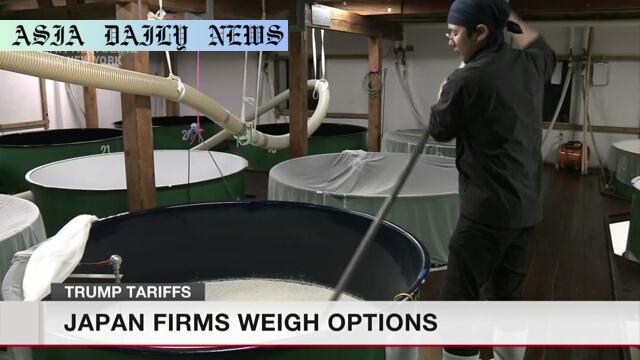US tariffs have left Japanese businesses facing tough choices.
US tariffs have created significant challenges for Japanese businesses on exports and manufacturing decisions.
A 10% tariff on sake and 25% duties on cars are changing Japanese production strategies.
Key corporations like Honda and Nissan are adapting their operations to manage costs and risks.

Understanding the Impact of US Tariffs on Japanese Firms
The US imposition of tariffs on Japanese goods has sent ripples through the business landscape, forcing companies to rapidly reassess their strategies. These measures have introduced a rather complex challenge in export-heavy industries, such as automotive and beverages. While policy decisions such as tariffs aim to bolster domestic industries, the fallout on international trade relations and established supply chains is immense. Japanese companies, known for their precision and long-term planning, now face disruptions that are difficult to overcome without significant restructuring.
Take, for example, Shata Brewery, a traditional sake production company based in Ishikawa. Its exports to the United States were performing satisfactorily until the imposition of a new 10% tariff earlier this year. This sudden increase in costs places an unexpected financial burden on companies that thrive on competitive pricing in global markets. For firms with both centuries of history and reliance on overseas buyers, the strain of adapting supply chains and channel strategies could come at an enormous operational cost. Meanwhile, larger firms like Nissan and Honda are dealing with the ripple effects of a 25% tariff on Japanese automotive exports, leading to major shifts in production status quo.
Production Adjustments for Survival
Honda and Nissan illustrate two approaches firms are attempting to combat the challenges created by tariffs. Honda Motor, to mitigate these additional costs, has moved its production of hybrid sedans destined for the US market from Japan to existing facilities in Indiana. This strategic decision is aimed not just at avoiding the 25% tariff, but also strengthening local market ties and ensuring smoother operations with reduced transportation costs. On the other hand, Nissan Motor, which scrapped plans to curtail production in its Tennessee facility, has opted to maintain its current level of operations in the US. Both scenarios underline a significant pivot in planning and foresight with operations shifted to regions less affected by new tariffs.
While such realignment could introduce efficiencies, they often result in upheaval across other sectors of the business. Workers affected by these changes in Japanese plants, changes in the supply chain, and fluid inventory strategies are just some of the challenges these firms face in the short to medium term. Yet Japanese companies are aware of the long-term outlook, even amidst an atmosphere defined by trade restrictions and increasing uncertainties stemming from rapid tariff measures.
Broad Implications for Economic Policy and Trade
Besides their direct impact on companies, tariffs raise broader questions concerning economic relations between Japan and the United States. Economies built upon globalization and mutual growth now navigate an increasingly protectionist outlook from key participants. The 25% tariffs on automobiles, particularly critical to Japan’s GDP, could impact national exports significantly unless proper negotiations or strategies are introduced. With production transitioning to the US, jobs in Japan face potential instability, creating internal economic waves as firms attempt to adhere to both domestic welfare and foreign policies.
Industries beyond automobiles have reasons for concern, too. The sake industry, led by brands like Shata Brewery, points to how tariffs affect niche markets. Once flourishing, the appeal of traditional Japanese beverages in international markets suffers simply due to tightened financial margins. The knock-on effects on smaller businesses, local employment, and cultural exports have already made headlines and will likely grow louder in the near future.
To conclude, the imposition of US tariffs marks a transformative period for Japan’s economic landscape. For companies like Nissan, Honda, and Shata Brewery, the path forward demands agility, resilience, and innovative thinking to circumnavigate the economic obstacles in favor of steady progress. Meanwhile, the policymaking world must observe how these decisions play out globally, not merely between two nations but across international supply chains and market niches.
Commentary
The Complex Dynamics of Trade Tariffs
Trade tariffs are a double-edged sword, often positioned as tools to protect domestic industries but capable of causing significant disruption to the global economic landscape. When countries like the United States impose tariffs on foreign goods, the aftershocks resonate beyond direct revenue implications. Companies find themselves in an uphill battle to stabilize their bottom line while simultaneously adjusting to fast-changing geopolitical and economic realities.
How Japanese Firms are Adapting
The example of Japanese companies such as Honda and Nissan pivoting their production strategies is a testament to agility in the face of adversity. However, this agility comes at a cost – both financially and culturally. By moving production to the United States, local Japanese workers and communities connected to domestic manufacturing facilities face repercussions. At the same time, it’s necessary to applaud these companies for taking active steps to minimize the financial toll of US tariffs. Honda’s decision to leverage its Indiana plant is a strategic move to ensure profitability while aligning with foreign market demands.
Sustainability in Global Trade Policies
One cannot ignore the broader implications of sustained protectionism. While the goal may be to shelter domestic industries, the ripple effects often manifest as strained bilateral relationships that may hinder future cooperation. In the case of Japan and the US, the fallout of these tariffs extends far beyond economics – cultural exchange, innovation sharing, and trade partnerships all face the risk of being limited in such an environment. Efforts to reconsider and manage these policies more sustainably could foster harmony and growth for all involved.
In conclusion, addressing the challenges posed by tariffs requires a strategic, multifaceted approach. Japanese firms are doing their part, but policymakers on both sides of the spectrum need to step back and re-evaluate how such measures impact global progress.


